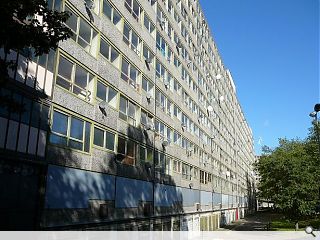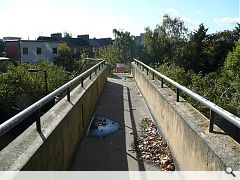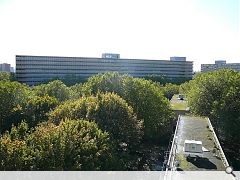Let’s get ready to Rubble
7 Dec 2010
The dust may have settled on Owen Luder’s Tricorn Centre in Portsmouth but the reverberations of its untimely demise echo still. With the debate over whether its demolition decision was the right one still raging we thought it high time to find out which buildings that are still standing will succeed this concrete charmer to assume the title of Britain’s best demolished building.
Open to any living architect to have had a building demolished in their lifetime, the club will host an annual ‘Wreckers Ball’ later this year whereupon our newest members will be inducted into our hall of fame. Each will be anointed with our custom wrecking ball badges at this event before we hand out our half brick trophy to the best. We are keen therefore to open this debate out to the wider public and find other diamonds in the rough the Rubble Club, www.rubbleclub.com, is on the hunt for structures whose future can be measured in months not years, whose value as roads aggregate exceeds its worth as a place and where love, care and attention have been subverted by hate, disdain and neglect.It is a busy time for the Club with a host of brutalist landmarks meeting equally brutal ends at the tip of wrecker’s ball or following a violent introduction to nitro glycerine. The world of architecture lies at the heart of a capitalist cut and thrust world of money, power and influence and this is reflected in the notable absence of fairytale endings for our members who are often more familiar with explosive denouements and abrupt full stops to their own (too) short stories. So is it better to go out with a bang or risk a slow and lingering fall from grace?
The next generation of Rubble contenders now constitutes the thrust of our coverage and we are spoilt for choice in potential challengers, bolstered by continuing demand for new homes and offices and a shortage of virgin land upon which to provide them. Unloved post war architecture has become an easy target for developers seeking pain free routes through an often tortuous planning process and is an obvious choice for regeneration chiefs keen to push through popular redevelopment of perceived eyesores.
Where older properties carry the weight of history and can count public affections in their favour many are all too happy to see their modern contemporaries razed without so much as a second glance. This is seeing vast swathes of tower blocks and council housing vanish from our cities and nowhere is this more apparent than London where the demands of an ever growing population are forcing a rethink of the capitals many scattered low density estates.from Aylesbury to Kidbrooke and, chief amongst them the infamous Heygate estate, long past its heyday.
Currently languishing empty and unloved he south London estate is awaiting redevelopment, its forest of towers and walkways set to be levelled for a higher density replacement which knits back into the surviving streetscape of Southwark. Completed in 1974 Heygate was initially popular with tenants who appreciated being handed a tidy new home with all the mod cons at a subsidised rent. In a familiar tale of decline however that optimism swiftly soured as residents and buildings succumbed to a rising tide of violence and crime associated with the economic turmoil of the seventies and eighties. In an attempt to put all that behind them Southwark Borough Council will team up with Lend Lease to deliver a £1.5bn masterplan which, it is hoped, will succeed where the last attempt failed.
Heygate as it stands at present is somewhat of a ghost town and a discombobulating experience for visitors. Primary pedestrian access stems from a series of walkways elevated amidst the foliage of the many mature trees which pepper the estate grounds. It is a tree top walkway entirely at odds with the all pervasive concrete which constitutes the rest of the area. Already sections of walkway lie fenced off with bright yellow ‘danger of death’ signs starkly proclaiming the life threatening possibilities inherent to continued passage across newly non existent sections of walkway. It is a glaring image amidst the overwhelming grey of the rest of the area and harbinger of the fate that will ultimately befall the remainder of the huge urban site.
Climbing a still accessible stairwell a different perspective on the scheme emerges however. Picking your way past used condoms, discarded drinks cans and excrement lies the welcome reprieve of a spectacular panorama of London’s nascent skyline. Though relatively modest in height the undemanding topography of the Thames valley has afforded tenants a spectacular unimpeded vista which compensates in large measure for the lack of beauty within by presenting it in spades without.
Comprising a series of interconnected slab blocks of a scale alien to the UK outside some of the more ambitious Glaswegian schemes the development has found scant favour with those unenthused by Soviet style architecture. Nonetheless the estate has found some unlikely support from the film industry as shorn of its inhabitants the sprawling agglomeration of abandoned housing has proved to be an irresistible spot for film and TV producers to go about their business unmolested. Offering a gritty and unobtrusive environment in which to shoot with the likes of Michael Caine, (Harry Brown) and Clint Eastwood (Hereafter) spotted ambling amongst the decay for their latest flicks. Low budget films have also got in on the act, amongst them “Attack the Block”, a sci-fi comedy dubbed “inner city vs. outer space”.
It’s not hard to see why they flock here, the austere precision of unrelenting grey rectangular masses stabbing through extensive greenery have served to provide an inhuman environment that serves as an appropriately telegenic cloth for characters seeking to bolster their anti hero status. Towering above it all and glistening in the sunlight was the New Jerusalem, a 43 storey leviathan that points to a more optimistic future for the area, though (incomprehensibly) it won BD’s Carbuncle Cup, to the chagrin of its designers, BFLS.
A diverse list of candidates are in the running this year, including John Madin’s Birmingham Post & Mail building, Nord’s East End Sawmill.It wouldn’t be a proper Rubble Club event without the participation of Luder however and so it is this year with Britain’s most resilient architect coming back for more. Luder himself is of course no stranger to such destructive demise but even he must be startled and saddened, by a turn of events that has seen cherished projects succumb one by one with the Tricorn’s demise followed in all too rapid succession by that of Gateshead car park. Ironically Michael Caine has more than a passing interest in this building having also shot a key scene in his 1970s flick, ‘Get Carter,’ within the concrete hulk. Sadly however the veteran actor hasn’t lent his voice in support of the structure, leaving it to Sylvester Stallone (star of the remake) to do the talking.
Caine was more forthcoming on Heygate though, he was reported as describing it as a "rotten place... which fortunately is being pulled down. It should never have been built." Coincidental or not other buildings to have played host to the Hollywood star must surely now be eyeing their futures with trepidation.
|
|
Read next: Mr Happy
Read previous: V&A at Dundee
Back to December 2010
Browse Features Archive
Search
News
For more news from the industry visit our News section.
Features & Reports
For more information from the industry visit our Features & Reports section.





